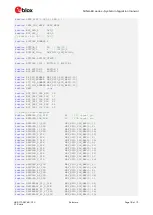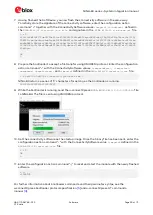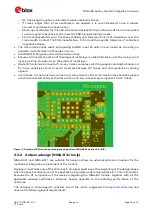
NINA-B3 series - System integration manual
UBX-17056748 - R13
Design-in
Page 32 of 72
C1-Public
3
Design-in
3.1
Overview
For an optimal integration of NINA-B3 series modules in the final application board, it is recommended
to follow the design guidelines described in this chapter. Every application circuit must be properly
designed to ensure that the related interface functions correctly, but a number of specific points
require special attention during the design of the application device.
The following list provides some important points sorted by rank of criticality in the application
design, starting from the highest relevance:
1.
Module antenna connection:
Ant
pad.
The antenna circuit affects the RF compliance of the device integrating the NINA-B3 modules with
the applicable certification schemes. Follow the
2.
Module supply:
VCC
,
VCC_IO
, and
GND
pins.
The supply circuit affects the performance of the device integrating the NINA-B3 series module.
Follow the
schematic and layout design recommendations.
3.
Analog signals: GPIO
Analog signals are sensitive to noise and should be routed away from high frequency signals.
4.
High speed interfaces:
UART, SPI
and
SWD
pins.
High speed interfaces can be a source of radiated noise and can affect compliance with regulatory
standards for radiated emissions. Follow the
serial interface (UART) design
5.
System functions:
RESET_N
,
I2C
,
GPIO
and other System input and output pins.
Accurate design is required to ensure that the voltage level is well defined during module boot.
6.
Other pins:
Accurate design is required to ensure proper functionality.
3.2
Design for NINA family
NINA-B3 is based on the Nordic nRF52840 chip that has larger dimensions when compared to the
nRF52832 that is used in NINA-B1. Because of this and to enable more GPIO pins underneath the
module, the size of the NINA-B3 series needs to be increased. For instance, the module size of the
NINA B3x2 is 10 x 15.0 mm as compared to the NINA-B112, which is 10 x 14.0 mm.
Pinouts for both the NINA-B1 and W1 are supported so that all modules in the NINA series can be
placed interchangeably on a common footprint. However, to accommodate the larger dimension of
the NINA-B3, a keep-out area of 1 mm should be reserved during design. Otherwise, the mechanical
design of the NINA-B3 is identical to the NINA-B1 and W1 modules.
3.3
Antenna interface
As the unit cannot be mounted arbitrarily, the placement should be chosen with consideration so that
it does not interfere with radio communications. The NINA-B3x2 variant that includes an internal
surface mounted antenna cannot be mounted inside a metal enclosure. No metal casing or plastics
using metal flakes should be used. Avoid metallic based paint or lacquer as well. NINA-B3x1 offers
more design freedom, as an external antenna can be mounted further away from the module.
















































